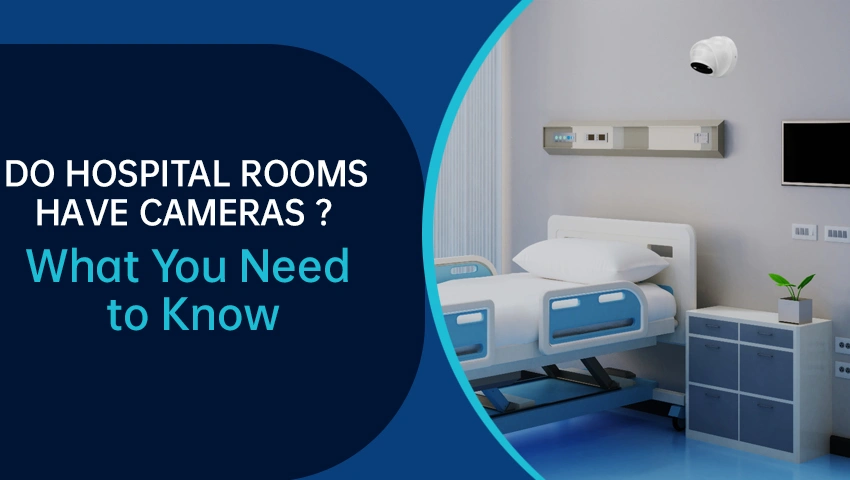In recent years, the healthcare industry has been increasingly turning to security and monitoring systems to ensure patient safety, improve care efficiency, and prevent incidents. These systems are crucial for hospitals to operate smoothly and to protect both patients and staff. As a result, many patients and their families are left wondering about the presence of cameras in hospital rooms, especially when it comes to privacy and security concerns. This article will explore why hospitals may use cameras, where they are typically located, the regulations that govern their use, and how they affect patients’ rights.
Contents
Why Hospitals Might Use Cameras
There are several reasons why hospitals choose to install cameras, though they are not typically used in patient rooms unless specifically required. Some of the primary reasons include:
1. Safety and Patient Monitoring
In critical care areas such as the Intensive Care Unit (ICU) or neonatal care units, cameras can be a valuable tool for monitoring patient conditions remotely. These cameras allow healthcare staff to observe a patient’s status continuously and respond quickly if their condition worsens. In high-risk areas, cameras can also act as an extra set of eyes to ensure that patient needs are being met.
2. Security Reasons to Prevent Unauthorized Access
Hospitals are busy places with many people coming and going, including visitors, staff, and patients. Cameras are used in hallways, entrances, and exits to monitor the flow of people and prevent unauthorized individuals from entering restricted areas. This surveillance helps keep sensitive areas, such as surgical rooms, safe from theft or security breaches.
3. Specialized Care Units:
Areas that handle sensitive cases, such as the ICU, psychiatric wards, and neonatal care units, may have surveillance cameras to help ensure the safety of both patients and staff. For example, psychiatric units may use cameras to monitor patients who might be a risk to themselves or others, ensuring timely intervention if necessary.
Where Cameras Are Typically Found in Hospitals
Hospitals are large facilities with many different areas that require surveillance. Cameras are commonly found in the following areas:
1. Common Areas with Security Cameras:
Most hospitals have security cameras installed in public spaces such as hallways, waiting rooms, cafeterias, and parking lots. These cameras are designed to monitor general activity, ensuring safety and preventing theft or violence. Hospitals often have surveillance around the perimeter and entrances to monitor who enters and exits.
2.Specialized Areas with Surveillance:
In more specialized areas such as the ICU, emergency rooms (ER), and operating theaters, cameras may be installed to ensure patient safety and improve operational efficiency. These cameras are usually aimed at observing the patient’s condition and assisting medical staff in monitoring vital signs. In these critical care areas, there may also be cameras monitoring procedures to ensure that medical protocols are followed.
3. Patient Rooms and Private Spaces:
While cameras are commonly placed in hallways and other public areas, patient rooms generally do not have cameras. Hospitals usually prioritize patient privacy in these spaces, meaning cameras are not typically installed unless there is a specific need for surveillance. This is particularly true in private rooms where patients expect a certain level of confidentiality.
Regulations and Privacy Concerns
Given the sensitive nature of healthcare, hospitals are required to comply with various regulations to protect patients’ privacy. One of the most important regulations in the U.S. is the **Health Insurance Portability and Accountability Act (HIPAA). HIPAA sets strict standards regarding the use of medical information and patient privacy, including the use of surveillance cameras.
1. Balancing Surveillance with Patient Confidentiality:
Hospitals must balance the need for security with the privacy rights of patients. Surveillance in public spaces, such as hallways, is generally considered acceptable, but cameras inside patient rooms would be subject to strict rules. Patients’ privacy must be preserved, especially in areas where personal and medical information is shared.
2. Consent for Camera Use in Patient Areas:
If a hospital room were to have cameras, patients would need to provide consent for surveillance. In some cases, hospitals might ask patients or their families to sign consent forms if cameras are used for monitoring purposes, particularly in specialized care units.
Do Hospital Rooms Have Cameras? A Closer Look
While security cameras are increasingly common in hospitals, **patient rooms** typically do not have cameras unless specifically needed. In general, hospitals respect the privacy of patients in these spaces, as patient dignity and confidentiality are crucial. However, there are exceptions:
1. Specialized Units:
Certain areas, such as psychiatric wards, may have cameras to monitor patients who could pose a risk to themselves or others. Similarly, isolation rooms used to prevent the spread of infections might have cameras to allow medical staff to monitor the patient remotely.
2. Alternative Monitoring Tools:
Even without cameras, hospitals have other tools to monitor patients. For example, intercom systems, remote monitoring devices, and electronic health records allow doctors and nurses to track patient vital signs, listen to alarms, and ensure that proper care is being provided. These tools can often provide sufficient monitoring without the need for direct camera surveillance in a patient’s room.
Pros and Cons of Cameras in Hospital Rooms
The use of cameras in hospital rooms presents both benefits and challenges. Here are some of the key pros and cons:
1. Benefits
- Enhanced Patient Safety: Surveillance can help improve patient safety, especially in high-risk areas such as the ICU. With cameras, healthcare workers can respond more quickly to emergencies, such as sudden changes in a patient’s condition.
- Prevention of Medical Errors: Cameras can serve as an additional layer of oversight, helping to prevent errors in patient care. For instance, surveillance can assist in monitoring the administration of medication or ensuring that staff follows proper protocols.
- Quick Response Times: In the event of an emergency, surveillance cameras can help staff quickly assess the situation, enabling faster intervention.
2. Drawbacks:
- Privacy Concerns: The most significant concern for patients is the potential violation of privacy. Many patients are uncomfortable with the idea of being monitored, particularly in sensitive areas such as their rooms or bathrooms.
- Stress and Discomfort: Some patients may feel stressed or uneasy knowing they are being watched, even if the camera is there to ensure their safety. This can lead to a feeling of a lack of autonomy or control over their environment.
How to Find Out If Your Hospital Room Has a Camera
If you are concerned about the possibility of a camera in your hospital room, here are some ways to find out:
1. Ask the Staff:
The best way to clarify whether cameras are in your room is to ask the hospital staff. They should be able to provide information about any monitoring systems in place and explain the hospital’s privacy policies.
2. Check for Visible Cameras:
If there are cameras in the room, they are likely to be visible, mounted on the ceiling or in a corner. Some hospitals may also have discreet signs that indicate surveillance is in place.
3. Request Information About Privacy Policies:
Hospitals are required to inform patients about their privacy policies. Reviewing this documentation can give you a better understanding of how the hospital handles surveillance and patient confidentiality.
Future Trends in Hospital Monitoring
As technology continues to advance, the healthcare industry is embracing new monitoring tools that can enhance patient care while maintaining privacy.
1. AI-Assisted Remote Monitoring:
Hospitals are increasingly using AI-powered systems to remotely monitor patients’ vital signs. These tools can analyze data in real-time and alert healthcare providers about any changes in a patient’s condition, potentially reducing the need for invasive surveillance.
2. Telemedicine and Remote Care:
As telemedicine grows, there may be a shift toward more remote monitoring. Instead of relying on cameras, healthcare providers could monitor patients’ health through wearable devices or virtual consultations, reducing the need for cameras in rooms.
FAQs
1. Are hospitals legally allowed to have cameras in patient rooms?
Generally, hospitals are not allowed to place cameras in patient rooms without the patient’s consent, as it would violate privacy regulations like HIPAA.
2. Can patients request rooms without cameras?
If cameras are present for safety reasons, hospitals may allow patients to opt out. However, this depends on the unit and the hospital’s specific policies.
3. How secure is the footage taken from hospital cameras?
Hospitals are required to follow strict protocols to secure camera footage. This typically involves encryption and limited access to authorized personnel to protect patient information.
Conclusion
As hospitals work to improve patient safety and care, surveillance systems will likely continue to play an essential role. However, ensuring a balance between security and patient privacy remains a key consideration. Clear communication between patients and healthcare providers is crucial to maintaining this balance and ensuring that patients’ rights are respected throughout their care. If you are ever concerned about the presence of cameras in your hospital room, don’t hesitate to ask about the hospital’s policies and procedures.

